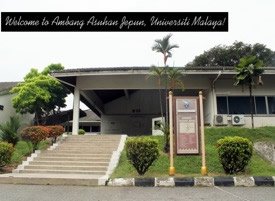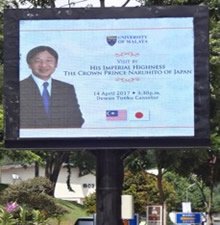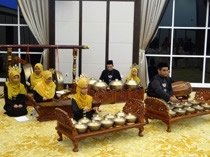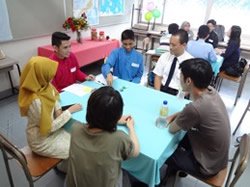Special Preparatory Programme to Japan (RPKJ), Center for Foundation Studies in Science, University of Malaya
Special Preparatory Programme to Japan (RPKJ), Center for Foundation Studies in Science, University of Malaya
DATE Kumiko (head of department), SATO Kyoko (in charge of Year 1), SHINOHARA Noriko (in charge of Year 2)
Proud to be Students Studying at the AAJ…
DATE Kumiko (head of department)
Malaysia’s capital of Kuala Lumpur is a major city lined with modern buildings, and even now there are skyscrapers being built everywhere. However, large trees that look like they belong in “My Neighbor Totoro” grow thickly between the buildings and create cool shade for the residents as they move around the city under the hot sunlight. Kuala Lumpur could be described as a major city that was literally born in the midst of this southern country’s natural environment.
The Special Preparatory Programme to Japan (RPKJ/commonly known as the AAJ) is a course affiliated to Universiti Malaya (UM)’s Centre for Foundation Studies in Science (PASUM).

AAJThe building of the Universiti Malaya
The AAJ was established in 1982 and celebrates its 36th year this year. This course is aimed at bumiputera (Malay Malaysian students), and is based the Look East Policy adopted in 1982. The selected students study Japanese and other subjects (mathematics, physics and chemistry) taught by Malay and Japanese teachers, and upon completion of those studies, provided they pass the prescribed examinations they can enroll as first year engineering students at a Japanese national university. Amid the agitation in the Malaysian economy, the number of enrollees fell to 60 last year, but in the current fiscal year the number is expected to be close to 80. This year the Japanese-language teachers comprise eight Japanese-Language Specialists dispatched by The Japan Foundation (two Senior Specialists, five Specialists and one Assistant), and 11 local Malaysian teachers.
In the case of first-year students, following a one-week orientation that takes place after they enroll, there is a two-week period of intensive Japanese-language classes. In these classes, hiragana and katakana are covered in the first week, and from the second week elementary Japanese sentence patterns and kanji are introduced. From 9 a.m. to 5 p.m. the students only attend Japanese classes. Spending two weeks taking classes that immerse them like a shower in the Japanese language, the new enrollees also grow accustomed to AAJ’s study methods and the overall lifestyle. Once the two-week period is over the normal classes (Semester 1) begin at last. In Semester 1, in addition to the Japanese-language classes the other subject classes with Malay teachers (mathematics, physics and chemistry) also begin, so aside from Saturdays and Sundays the students are studying at university from 8 a.m. until 6 p.m., and once they return to their dorms, they then have to deal with the homework they have been issued for the respective subjects, and prepare for quizzes, which leaves them three to four hours a day for sleep. The sight of the students studying desperately to ensure they do not get left behind is something to behold. From Semester 2 things become even more challenging as the students begin being taught their other subjects in Japanese.
Meanwhile, the second-year students have to take the first EJU examination, which is held in June, so as soon as they advance to their second year they begin studying to prepare for the exam. In addition to this exam, the results of a second EJU exam held in November and the results of a final exam in December will determine whether or not the second-year students can study in Japan, meaning they cannot let up on their daily studies. After taking close to nine hours of classes a day they must tackle a mountain of homework and prepare for quizzes and small tests that are held on an almost daily basis. They have even less time for sleep, and are compelled to do battle with psychological pressure on a daily basis.
As this shows, the AAJ could be described as constant study, but in order to enable the AAJ students to have a change of pace, albeit for a short time, a variety of activities are also incorporated into the curriculum. There are a large number of interesting events, including sports festivals, a Japanese-language speech contest, interaction with Japanese high school students, opportunities to talk to students who are ahead of them on the AAJ course, visits to Japanese companies and a kanji champion contest (for first-year students), and visits to Japanese families (for second-year students). Even among those activities, one event of this fiscal year that deserves special mention is the Crown Prince’s visit to Universiti Malaya on April 14.

Welcoming the Crown Prince
The Crown Prince’s message – “The amicable relationship between Japan and Malaysia cannot be discussed without mentioning the presence of the AAJ, the origin of the Look East Policy” – inspired a large number of students, and once again made them proud to be students taking the AAJ programme. Hafiz, the president of the AAJ’s student council, was honored by being addressed directly by the Crown Prince. This event gave rise to a magical memory not just for Hafiz himself but for the AAJ course also.
For AAJ students, entering a Japanese national university less than two years after they began studying Japanese from scratch could be summed up as nothing short of an “ordeal.” In order to ensure that those students do not lose motivation and are able to reach the point of studying in Japan, the Japanese teaching staff and Malaysian teaching staff work together as a team to sincerely address the students’ needs every day, while making every effort to encourage them.
Celebration for the 34th Intake of Students: Giving Thanks to Those Who Went Before Us
SATO Kyoko (in charge of Year 1)
Immediately after they enroll, the AAJ students’ lives revolve around studying from 8 a.m. to 6 p.m. every day. In addition to the Japanese language, which they study for the first time, they also need to study subjects in Japanese in order to pass the Examination for Japanese University Admission for International Students. Even looked at from a teacher’s perspective, the students face an extremely busy two years. And at the end of those efforts, only the students who have passed the examination are able to study in Japan.
In order to recognize the efforts of these graduating students, a celebration is held every year in February. This celebration is planned by a steering committee made up of first-year students, to express their thanks to their seniors, who studied the AAJ alongside them. Naturally, the Malay teachers provide support in the areas the students cannot manage on their own, but on the day itself the running of the event centers entirely on first-year students. The first-year students have enrolled in May with zero knowledge of the Japanese language, and it moves me to tears to see them running the celebration in Japanese. Furthermore, it is conceivable that opportunities such as this gradually instill in them the independence they will need in Japan as well.
The students come up with the program for the celebration themselves, so it changes every year. This year’s program apparently placed a greater emphasis on production and decoration than in normal years, so undoubtedly quite a bit of time was spent on preparations. When I hear the first-year students talk about how they prepared during breaks in their own studies, how all those involved stayed up late the night before the celebration preparing, and how they want the seniors to enjoy the event, it makes me realize that there is a strong sense of “caring about others” in the Malaysian culture.

First-year students playing traditional Malaysian musical instruments
A performance that used traditional Malaysian musical instruments was particularly superb. Apparently, one of the students taught the other students how to play and they all practiced together. This live performance was deeply moving for the Japanese teaching staff as well. As teachers, we want our students to put self-driven initiatives such as this into practice.

Muhammad Almahdi bin Razali, president of the students’ association for second-year students (34th intake)
The AAJ students who planned this celebration belong to the 35th intake, and they are scheduled to embark on studying in Japan in March 2018. They will thus go from being the ones doing the sending off to being the ones being sent off. It is my sincere hope that the students’ daily efforts bear fruit.
Through Interaction with Japanese High School Students…
SHINOHARA Noriko (in charge of Year 2)
Classes for second-year AAJ students are held entirely in Japanese. A look at the class syllabus for second-year students for a certain week reveals terms such as “infinite geometric series,” “covalent crystals” and “parametric representation.” It contains a long string of phrases that we Japanese-language teachers are unfamiliar with. During the “class observation week” the teachers of mathematics, chemistry, physics and Japanese observe each other’s classes and come back from the classrooms mutually surprised at the difficulty of the content being covered in those classes. It is not difficult to imagine how hard it is for the students. Even looking at educational institutions worldwide, the AAJ is the only course of its kind, I believe.
The second-year students are immersed in study while being immersed in the Japanese language at the same time, but regrettably, there are not many opportunities for them to speak Japanese with people of their own age. However, on two occasions in fiscal 2016 school events were held that gave them the opportunity to interact with Japanese high school students.
The first was an interaction with Okayama Prefectural Okayama Joto High School in June. In terms of timing, this was before the first Examination for Japanese University Admission for International Students (hereinafter “EJU”). It was therefore not possible to secure the time for genuine interaction, and so the interaction took the form of the high school students taking part in an AAJ composition class. The EJU includes a descriptive problem, whereby the examinees state their own views on an issue they are presented with. In order to present an objective view, it is necessary to consider a theme from various angles, and so in the composition classes held at this time themes are decided and are discussed in groups in a “brainstorming” format. For the interaction in June, I had the Japanese high school students take part in this discussion. Wherever possible, for the themes that were to be discussed I selected topics that have no “correct answer” and that different people will have different thoughts on, such as “Is competition needed in the world?” and “Should you select a job out of the things you love doing?” The students got to experience firsthand something that is extremely obvious – namely, “In some cases people from different countries and cultures have the same ideas, and conversely sometimes people from the same country have different views” – and they apparently developed a feeling of affinity with each other. It is also extremely obvious that as a language, Japanese is something you use to express your own thoughts and to understand one another. However, this was something the AAJ students are normally unable to experience firsthand, given that during their classes they ultimately tend to be “listening” to Japanese. The students were timid initially, but by the end they appeared to be a little more animated than usual, and could discuss their own thoughts enthusiastically. The students were able to spend the time fruitfully and enjoyably.
The second event was an interaction with Fukuoka Prefectural Musashidai High School in February, just before the AAJ students were set to study in Japan. Partly because they were just about to study abroad, I decided to focus on a period of free interaction in small groups so that the students would be able to talk freely, asking and discussing the things they wanted to. I secretly listened to the students’ questions from behind – “What sort of foreigners do you want to become friends with?”; “What should foreigners do when they want to make friends with Japanese people?”; “Given how poor my Japanese is, will Japanese people be kind enough to want to become friends with me?” It was somehow painful to listen to their honest feelings and sincere thoughts about wanting to make Japanese friends. I sensed very keenly that despite studying so hard and spending every day immersed in the Japanese language like this, perhaps unsurprisingly they were anxious about studying abroad. And it made me think about how I could go about equipping them with sufficient Japanese-language skills to allow them to overcome that anxiety. I also want the students to acquire as much conversational Japanese for communication as possible, and a knowledge of the Japanese culture to give them a foundation for that. At the same time, however, securing a high score in the EJU is a condition of them studying in Japan, so neither is it possible to reduce the time allocated to that goal. The challenges presented to Japanese- Language Specialists assigned to the AAJ are how to teach as much as possible in a short and limited time, how to teach it more efficiently, and how to have the students learn. What do the students in front of us need now, while keeping in mind the path of studying in Japan that they will likely follow in the future, and what can we do to realize that? We continue to earnestly address these questions each day.

A visitor session
- What We Do Top
- Arts and Cultural Exchange [Culture]
- Japanese-Language Education Overseas [Language]
- Japanese-Language Education Overseas [Language] Top
- Learn Japanese-language
- Teach Japanese-language
- Take Japanese-Language Test
- Know about Japanese-language education abroad
- The Japanese-Language Institute, Urawa
- The Japanese-Language Institute, Kansai
- Japanese-Language Programs for Foreign Specified Skilled Worker Candidates
- Japanese Language Education for Japanese Children Resident Overseas and for the Descendants of Migrants
- Archives
- Japanese Studies and Global Partnerships [Dialogue]
- JF digital collection
- Other Programs / Programs to Commemorate Exchange Year
- Awards and Prizes
- Publications
